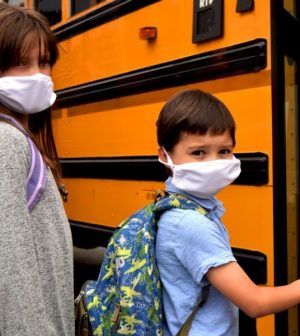- Skip Storing This Everyday Product in the Fridge Door
- Green Tea + B3 Pairing May Boost Brain Health
- Navigating Your Midlife Crisis: Embracing New Possibilities
- City Raccoons Showing Signs of Domestication
- Mapping the Exposome: Science Broadens Focus to Environmental Disease Triggers
- One Week Less on Social Media Linked to Better Mental Health
- Your Brain Changes in Stages as You Age, Study Finds
- Some Suicide Victims Show No Typical Warning Signs, Study Finds
- ByHeart Formula Faces Lawsuits After Babies Sickened With Botulism
- Switch to Vegan Diet Could Cut Your Greenhouse Gas Emissions in Half
CDC Says 3 Feet of Social Distancing Now OK in Most Classrooms

In a move that should make reopening schools an easier task, the U.S. Centers for Disease Control and Prevention on Friday lowered its social distancing recommendation for most classrooms to 3 feet.
That should enable many schools to keep all students enrolled in a class within the same room.
“[The] CDC is committed to leading with science and updating our guidance as new evidence emerges,” CDC Director Dr. Rochelle Walensky said in an agency news release. Until now, 6 feet of social distancing was recommended.
“Safe in-person instruction gives our kids access to critical social and mental health services that prepare them for the future, in addition to the education they need to succeed,” Walensky added. “These updated recommendations provide the evidence-based road map to help schools reopen safely, and remain open, for in-person instruction.”
Based on the latest science, the CDC recommends students in elementary schools maintain a distance of at least 3 feet in classrooms where mask use is universal, regardless of whether community transmission of COVID-19 is low, moderate, substantial or high.
In middle and high schools, students should be at least 3 feet apart in classrooms where mask use is universal and in communities where transmission is low, moderate or substantial.
Middle school students and high school students should remain at least 6 feet apart in communities where transmission is high, unless cohorting is possible, the CDC said.
Cohorting is when groups of students remain with the same peers and staff throughout the school day, to lower the risk of COVID-19 spread throughout the school.
The recommendations vary because older students are more likely to be exposed to and spread the coronavirus that causes COVID-19 than younger children, the CDC said.
The agency noted that three studies published in the March 19 issue of its publication Morbidity and Mortality Weekly Report add to evidence that physical distancing of at least 3 feet between students is safe in classrooms where there is universal mask use and other prevention measures in place.
The agency continues to recommend at least 6 feet of distance: between adults in the school building and between adults and students; in common areas, such as school lobbies and auditoriums; when masks can’t be worn, such as when eating; and in community settings outside the classroom.
Maintaining 6 feet of distance is also still recommended during activities that involve increased exhalation, such as singing, shouting, band practice, sports or exercise. These activities should be done outdoors or in large, well-ventilated spaces whenever possible, the CDC advised.
“Given the crucial services schools offer and the benefits of in-person learning, it is critical for K-12 schools to open and remain open for in-person instruction, as safely and as soon as possible,” the agency said. “Schools should be the last settings to close because of COVID-19 and the first to reopen when they can do so safely.”
More information
The U.S. Centers for Disease Control and Prevention has more on children, teens and COVID-19.
SOURCE: U.S. Centers for Disease Control and Prevention, news release, March 19, 2021
Source: HealthDay
Copyright © 2025 HealthDay. All rights reserved.










